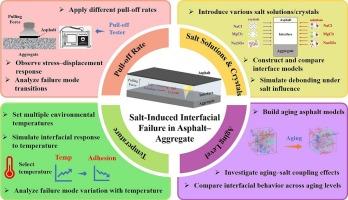多相盐溶液/晶体环境下盐诱导沥青-骨料体系界面破坏的原子机制:分子模拟和实验室观察
IF 6.9
2区 材料科学
Q2 CHEMISTRY, PHYSICAL
引用次数: 0
摘要
沿海、寒冷和盐碱地沥青路面由于复杂的盐碱地环境而面临耐久性威胁。盐以溶液或结晶的形式存在于沥青混合料中,削弱沥青-骨料的附着力,加速混合料变质。在这项研究中,进行了分子动力学模拟,以探索NaCl, MgCl2和Na2SO4如何以溶液或晶体形式存在,并改变沥青-骨料界面。研究了原始、轻度老化和严重老化沥青粘结剂的界面力学响应和破坏模式。通过模拟拉脱试验量化了拉脱率、温度、盐环境和老化水平的综合影响,并通过宏观实验验证了拉脱率的影响。结果表明:盐溶液显著降低界面结合强度和断裂能,导致粘结破坏;NaCl溶液引起的变质基本上是不可逆的。相比之下,盐晶体表现出不同的作用:Na2SO4和NaCl晶体促进粘接破坏,保持或改善粘接,而MgCl2晶体强烈吸附在沥青界面上,导致粘接破坏。此外,沥青老化对界面强度的影响表现为双重效应,粘结破坏时界面强度提高,粘结破坏时界面强度降低。这些见解阐明了盐诱导沥青界面损伤的分子机制。本文章由计算机程序翻译,如有差异,请以英文原文为准。

Atomistic mechanisms of salt-induced interfacial failure in asphalt–aggregate systems under multiphase salt solution/crystal environments: molecular simulation and laboratory observation
Asphalt pavements in coastal, frigid, and saline–alkali soil regions face durability threats due to complex saline environments. Salts exist in asphalt mixtures in the form of solutions or crystals, weakening asphalt–aggregate adhesion and accelerating mixture deterioration. In this study, the molecular dynamics simulations were performed to explore how NaCl, MgCl2, and Na2SO4, present as either solutions or crystals, and alter the asphalt–aggregate interface. The interfacial mechanical response and failure modes were examined for virgin, mildly aged, and severely aged asphalt binders. The combined influence of pull-off rate, temperature, salt environment, and aging level was quantified by simulated pull-off tests, and validated by macroscopic experiments. The results showed that salt solutions significantly decreased interfacial bond strength and fracture energy, typically leading to adhesive failure; the deterioration caused by NaCl solution is essentially irreversible. In contrast, salt crystals exhibited divergent effects: Na2SO4 and NaCl crystals promoted cohesive failure and preserved or improved adhesion, whereas MgCl2 crystals strongly adsorbed onto the asphalt interface, inducing adhesive failure. Moreover, asphalt aging exhibited dual effects on interfacial strength, enhancing it in cohesive failure scenarios but reducing it in adhesive ones. These insights clarify the molecular mechanisms of salt-induced damage in asphalt interfaces.
求助全文
通过发布文献求助,成功后即可免费获取论文全文。
去求助
来源期刊

Applied Surface Science
工程技术-材料科学:膜
CiteScore
12.50
自引率
7.50%
发文量
3393
审稿时长
67 days
期刊介绍:
Applied Surface Science covers topics contributing to a better understanding of surfaces, interfaces, nanostructures and their applications. The journal is concerned with scientific research on the atomic and molecular level of material properties determined with specific surface analytical techniques and/or computational methods, as well as the processing of such structures.
 求助内容:
求助内容: 应助结果提醒方式:
应助结果提醒方式:


